-
82 results in Exploration of Foods and FoodomicsSort byMost Cited
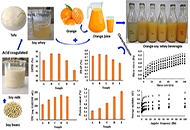 Development of soy whey fortified orange juice beverages: their physicochemical, rheological, antioxidant, and sensory propertiesOpen AccessOriginal ArticleAim: Soy whey is a byproduct of tofu production and is being discarded after tofu preparation. However, soy whey is a rich source of phytochemicals, minerals, and protein. The present study was c [...] Read more.Hilal Ahmad Punoo ... Andleeb MuzaffarPublished: October 29, 2023 Explor Foods Foodomics. 2023;1:206–220
Development of soy whey fortified orange juice beverages: their physicochemical, rheological, antioxidant, and sensory propertiesOpen AccessOriginal ArticleAim: Soy whey is a byproduct of tofu production and is being discarded after tofu preparation. However, soy whey is a rich source of phytochemicals, minerals, and protein. The present study was c [...] Read more.Hilal Ahmad Punoo ... Andleeb MuzaffarPublished: October 29, 2023 Explor Foods Foodomics. 2023;1:206–220
DOI: https://doi.org/10.37349/eff.2023.00016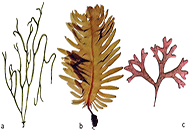 Atlantic algae as food and their extractsOpen AccessReviewAmong the species of the rich algological flora of the North Atlantic, some can be used for direct consumption in human food, although few are currently cultivated on a large scale and/or marketed f [...] Read more.Leonel PereiraPublished: April 27, 2023 Explor Foods Foodomics. 2023;1:15–31
Atlantic algae as food and their extractsOpen AccessReviewAmong the species of the rich algological flora of the North Atlantic, some can be used for direct consumption in human food, although few are currently cultivated on a large scale and/or marketed f [...] Read more.Leonel PereiraPublished: April 27, 2023 Explor Foods Foodomics. 2023;1:15–31
DOI: https://doi.org/10.37349/eff.2023.00003
This article belongs to the special issue The food (r)evolution towards food quality/security and human nutrition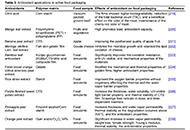 Recent advances in nano-related natural antioxidants, their extraction methods and applications in the food industryOpen AccessReviewNatural antioxidants, such as phenolic compounds, carotenoids, vitamins, and microelements, are predominant in fruits, vegetables, herbs, and spices. The accretion interest of consumers in utilizing [...] Read more.Ayla Elmi Kashtiban ... Sayna ZahediniaPublished: April 19, 2024 Explor Foods Foodomics. 2024;2:125–154
Recent advances in nano-related natural antioxidants, their extraction methods and applications in the food industryOpen AccessReviewNatural antioxidants, such as phenolic compounds, carotenoids, vitamins, and microelements, are predominant in fruits, vegetables, herbs, and spices. The accretion interest of consumers in utilizing [...] Read more.Ayla Elmi Kashtiban ... Sayna ZahediniaPublished: April 19, 2024 Explor Foods Foodomics. 2024;2:125–154
DOI: https://doi.org/10.37349/eff.2024.00030
This article belongs to the special issue The food (r)evolution towards food quality/security and human nutrition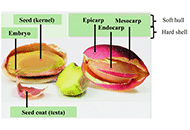 Nutritional and bioactive characterization of pistachio—a review with special focus on healthOpen AccessReviewThis paper reviews the nutritional quality and safety of edible farmed insects from the point of view of the Czech-Slovenian bilateral project: Quality, Safety and Authenticity of Insect Protein-bas [...] Read more.Juliana Ripari Garrido ... María Victoria SalinasPublished: July 26, 2024 Explor Foods Foodomics. 2024;2:363–390
Nutritional and bioactive characterization of pistachio—a review with special focus on healthOpen AccessReviewThis paper reviews the nutritional quality and safety of edible farmed insects from the point of view of the Czech-Slovenian bilateral project: Quality, Safety and Authenticity of Insect Protein-bas [...] Read more.Juliana Ripari Garrido ... María Victoria SalinasPublished: July 26, 2024 Explor Foods Foodomics. 2024;2:363–390
DOI: https://doi.org/10.37349/eff.2024.00042
This article belongs to the special issue Delivery of Hydrophobic Compounds in Food Systems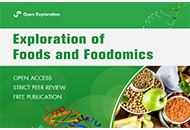 AI-powered revolution in plant sciences: advancements, applications, and challenges for sustainable agriculture and food securityOpen AccessReviewArtificial intelligence (AI) is revolutionizing plant sciences by enabling precise plant species identification, early disease diagnosis, crop yield prediction, and precision agriculture optimizatio [...] Read more.Deependra Kumar Gupta ... Ajay Kumar SinghPublished: August 06, 2024 Explor Foods Foodomics. 2024;2:443–459
AI-powered revolution in plant sciences: advancements, applications, and challenges for sustainable agriculture and food securityOpen AccessReviewArtificial intelligence (AI) is revolutionizing plant sciences by enabling precise plant species identification, early disease diagnosis, crop yield prediction, and precision agriculture optimizatio [...] Read more.Deependra Kumar Gupta ... Ajay Kumar SinghPublished: August 06, 2024 Explor Foods Foodomics. 2024;2:443–459
DOI: https://doi.org/10.37349/eff.2024.00045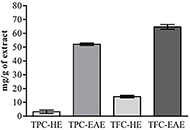 Azadirachta indica A. Juss (neem) phenolic extract inhibits human B-lymphoblastoid cells growth via cell cycle arrest, apoptosis induction, and DNA damageOpen AccessOriginal ArticleAim: As far as is known, the pharmaceutical effects of neem on human B-lymphoblastoid (TK6) cells have not been studied until now. Hence, the present study aimed to obtain neem phenolic extracts [...] Read more.Klebson Silva Santos ... Maria Beatriz Pinto Prior OliveiraPublished: August 29, 2023 Explor Foods Foodomics. 2023;1:130–142
Azadirachta indica A. Juss (neem) phenolic extract inhibits human B-lymphoblastoid cells growth via cell cycle arrest, apoptosis induction, and DNA damageOpen AccessOriginal ArticleAim: As far as is known, the pharmaceutical effects of neem on human B-lymphoblastoid (TK6) cells have not been studied until now. Hence, the present study aimed to obtain neem phenolic extracts [...] Read more.Klebson Silva Santos ... Maria Beatriz Pinto Prior OliveiraPublished: August 29, 2023 Explor Foods Foodomics. 2023;1:130–142
DOI: https://doi.org/10.37349/eff.2023.00011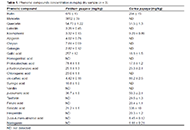 Phytochemical screening of Psidium guajava and Carica papaya leaves aqueous extracts cultivated in Greece and their potential as health boostersOpen AccessOriginal ArticleAim: The scope of the present study was to investigate the phytochemical profile of Psidium guajava and Carica papaya leaves aqueous extracts, from plants cultivated on Crete island in Greece. [...] Read more.Dimitrios D. Ntakoulas ... Charalampos ProestosPublished: April 26, 2023 Explor Foods Foodomics. 2023;1:5–14
Phytochemical screening of Psidium guajava and Carica papaya leaves aqueous extracts cultivated in Greece and their potential as health boostersOpen AccessOriginal ArticleAim: The scope of the present study was to investigate the phytochemical profile of Psidium guajava and Carica papaya leaves aqueous extracts, from plants cultivated on Crete island in Greece. [...] Read more.Dimitrios D. Ntakoulas ... Charalampos ProestosPublished: April 26, 2023 Explor Foods Foodomics. 2023;1:5–14
DOI: https://doi.org/10.37349/eff.2023.00002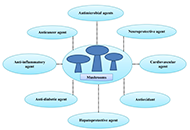 A concise review: edible mushroom and their medicinal significanceOpen AccessReviewIn many areas of human life, including food, health, culture, and religion, mushrooms have had a significant impact. Most people eat mushrooms for their flavor and texture. Recently, they have gained [...] Read more.Jaya P. Ambhore ... Bhavana A. ShendePublished: May 17, 2024 Explor Foods Foodomics. 2024;2:183–194
A concise review: edible mushroom and their medicinal significanceOpen AccessReviewIn many areas of human life, including food, health, culture, and religion, mushrooms have had a significant impact. Most people eat mushrooms for their flavor and texture. Recently, they have gained [...] Read more.Jaya P. Ambhore ... Bhavana A. ShendePublished: May 17, 2024 Explor Foods Foodomics. 2024;2:183–194
DOI: https://doi.org/10.37349/eff.2024.00033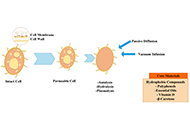 Encapsulation of hydrophobic compounds in yeast cells: methods, characterization, and applicationsOpen AccessReviewEncapsulation is a pivotal technique for protecting and enhancing the efficiency of sensitive natural bioactive substances, notably essential oils, vitamins, and phenolic compounds, widely used in [...] Read more.Deniz Günal-Köroğlu ... Esra CapanogluPublished: June 20, 2024 Explor Foods Foodomics. 2024;2:252–274
Encapsulation of hydrophobic compounds in yeast cells: methods, characterization, and applicationsOpen AccessReviewEncapsulation is a pivotal technique for protecting and enhancing the efficiency of sensitive natural bioactive substances, notably essential oils, vitamins, and phenolic compounds, widely used in [...] Read more.Deniz Günal-Köroğlu ... Esra CapanogluPublished: June 20, 2024 Explor Foods Foodomics. 2024;2:252–274
DOI: https://doi.org/10.37349/eff.2024.00037
This article belongs to the special issue Delivery of Hydrophobic Compounds in Food Systems Correlation distance of browning characteristic and polyphenol distribution in apple slices from 20 Chinese cultivarsOpen AccessOriginal ArticleAim: The aim of this study is to investigate the polyphenol composition and distribution in the core, flesh, and peel of 20 apple varieties from China and its relation with browning characteristi [...] Read more.Wenyue Wang ... Jinfeng BiPublished: June 08, 2023 Explor Foods Foodomics. 2023;1:62–71
Correlation distance of browning characteristic and polyphenol distribution in apple slices from 20 Chinese cultivarsOpen AccessOriginal ArticleAim: The aim of this study is to investigate the polyphenol composition and distribution in the core, flesh, and peel of 20 apple varieties from China and its relation with browning characteristi [...] Read more.Wenyue Wang ... Jinfeng BiPublished: June 08, 2023 Explor Foods Foodomics. 2023;1:62–71
DOI: https://doi.org/10.37349/eff.2023.00006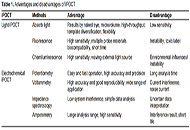 Intelligent point of care test for food safety via a smartphoneOpen AccessReviewThe on-site, rapid, and intelligence detection methods are the wave in food safety. Recently, intelligent point-of-care test (iPOCT) methods serve as a promising alternative for advanced monitoring [...] Read more.Le Zhang ... Zhaowei ZhangPublished: August 30, 2023 Explor Foods Foodomics. 2023;1:143–161
Intelligent point of care test for food safety via a smartphoneOpen AccessReviewThe on-site, rapid, and intelligence detection methods are the wave in food safety. Recently, intelligent point-of-care test (iPOCT) methods serve as a promising alternative for advanced monitoring [...] Read more.Le Zhang ... Zhaowei ZhangPublished: August 30, 2023 Explor Foods Foodomics. 2023;1:143–161
DOI: https://doi.org/10.37349/eff.2023.00012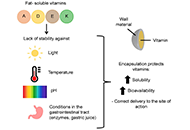 Leguminous fractions as encapsulating agents of fat-soluble vitaminsOpen AccessReviewVitamins are essential micronutrients for the functioning of the human body. Vitamins can be classified as water-soluble and fat-soluble, and are obtained through diet or supplementation. Fat-solubl [...] Read more.Angela Daniela Carboni ... María Cecilia PuppoPublished: February 23, 2024 Explor Foods Foodomics. 2024;2:30–42
Leguminous fractions as encapsulating agents of fat-soluble vitaminsOpen AccessReviewVitamins are essential micronutrients for the functioning of the human body. Vitamins can be classified as water-soluble and fat-soluble, and are obtained through diet or supplementation. Fat-solubl [...] Read more.Angela Daniela Carboni ... María Cecilia PuppoPublished: February 23, 2024 Explor Foods Foodomics. 2024;2:30–42
DOI: https://doi.org/10.37349/eff.2024.00024
This article belongs to the special issue Delivery of Hydrophobic Compounds in Food Systems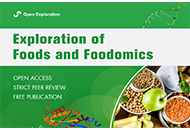 High intake of sunflower seeds and low mortality from Alzheimer’s disease and dementia: is there a correlation?Open AccessPerspectiveAlzheimer’s disease, a progressive and irreversible neurodegenerative disorder, is the most prevalent form of dementia with an increasingly growing incidence rate worldwide. As no effective therap [...] Read more.Katrin SakPublished: March 18, 2024 Explor Foods Foodomics. 2024;2:101–106
High intake of sunflower seeds and low mortality from Alzheimer’s disease and dementia: is there a correlation?Open AccessPerspectiveAlzheimer’s disease, a progressive and irreversible neurodegenerative disorder, is the most prevalent form of dementia with an increasingly growing incidence rate worldwide. As no effective therap [...] Read more.Katrin SakPublished: March 18, 2024 Explor Foods Foodomics. 2024;2:101–106
DOI: https://doi.org/10.37349/eff.2024.00028 Current analytical methods and applications used in the insight of serum proteins interactions with various food additives, pesticides, and contaminantsOpen AccessReviewIn recent years, many societies have expressed increasing apprehension regarding the potential negative impacts of food additives, pesticides, and environmental contaminants on human health. [...] Read more.Cem Erkmen, Md. Zahirul KabirPublished: May 24, 2024 Explor Foods Foodomics. 2024;2:195–222
Current analytical methods and applications used in the insight of serum proteins interactions with various food additives, pesticides, and contaminantsOpen AccessReviewIn recent years, many societies have expressed increasing apprehension regarding the potential negative impacts of food additives, pesticides, and environmental contaminants on human health. [...] Read more.Cem Erkmen, Md. Zahirul KabirPublished: May 24, 2024 Explor Foods Foodomics. 2024;2:195–222
DOI: https://doi.org/10.37349/eff.2024.00034
This article belongs to the special issue New Generation Analytical Technologies in Food Analysis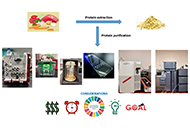 Separation methods for food protein purification and analysisOpen AccessReviewThe extraction, separation, and purification of dietary proteins from a variety of food sources are crucial for their targeted use in food applications. To achieve this, proteins should be effectively separated from non-protein co [...] Read more.Anushi Madushani Wijethunga, Chijioke EmenikePublished: July 30, 2024 Explor Foods Foodomics. 2024;2:391–407
Separation methods for food protein purification and analysisOpen AccessReviewThe extraction, separation, and purification of dietary proteins from a variety of food sources are crucial for their targeted use in food applications. To achieve this, proteins should be effectively separated from non-protein co [...] Read more.Anushi Madushani Wijethunga, Chijioke EmenikePublished: July 30, 2024 Explor Foods Foodomics. 2024;2:391–407
DOI: https://doi.org/10.37349/eff.2024.00043
This article belongs to the special issue Food Authenticity and Emerging Challenges of Novel Food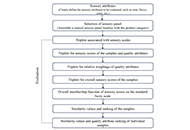 Application of fuzzy logic techniques for sensory evaluation of plant-based extrudates fortified with bioactive compoundsOpen AccessOriginal ArticleAim: This study aims to evaluate the sensory profile of corn-based extrudates fortified with phytosterol and pea protein isolates (PPI) using the fuzzy logic technique to assess similarity values [...] Read more.Mekala Pavani ... Sushil Kumar SinghPublished: December 29, 2023 Explor Foods Foodomics. 2023;1:272–287
Application of fuzzy logic techniques for sensory evaluation of plant-based extrudates fortified with bioactive compoundsOpen AccessOriginal ArticleAim: This study aims to evaluate the sensory profile of corn-based extrudates fortified with phytosterol and pea protein isolates (PPI) using the fuzzy logic technique to assess similarity values [...] Read more.Mekala Pavani ... Sushil Kumar SinghPublished: December 29, 2023 Explor Foods Foodomics. 2023;1:272–287
DOI: https://doi.org/10.37349/eff.2023.00021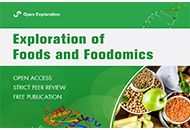 Olive oil, fruit and leaves in diabetes mellitus type 2 treatmentOpen AccessReviewThe Mediterranean dietary pattern, where extra virgin olive oil (EVOO) takes the central spot, is related to longer life expectancy and lower risk of a number of non-communicable diseases, including [...] Read more.Mario Nosić ... Ines BanjariPublished: October 29, 2023 Explor Foods Foodomics. 2023;1:192–205
Olive oil, fruit and leaves in diabetes mellitus type 2 treatmentOpen AccessReviewThe Mediterranean dietary pattern, where extra virgin olive oil (EVOO) takes the central spot, is related to longer life expectancy and lower risk of a number of non-communicable diseases, including [...] Read more.Mario Nosić ... Ines BanjariPublished: October 29, 2023 Explor Foods Foodomics. 2023;1:192–205
DOI: https://doi.org/10.37349/eff.2023.00015
This article belongs to the special issue Natural Products in Health and Disease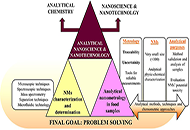 Monitoring nanomaterials in food: a critical overview, perspectives, and challengesOpen AccessReviewNanoscience and nanotechnology have experienced a dizzying development in recent years, which undoubtedly contributes to various fields of human activity such as biotechnology, engineering, medical [...] Read more.Natalia Villamayor ... Ángel RíosPublished: April 27, 2023 Explor Foods Foodomics. 2023;1:43–61
Monitoring nanomaterials in food: a critical overview, perspectives, and challengesOpen AccessReviewNanoscience and nanotechnology have experienced a dizzying development in recent years, which undoubtedly contributes to various fields of human activity such as biotechnology, engineering, medical [...] Read more.Natalia Villamayor ... Ángel RíosPublished: April 27, 2023 Explor Foods Foodomics. 2023;1:43–61
DOI: https://doi.org/10.37349/eff.2023.00005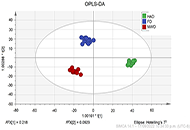 1H NMR-based metabolomics of cacao pod husk: profile comparison of three drying treatmentsOpen AccessOriginal ArticleAim: The aim of this study is to apply untargeted proton nuclear magnetic resonance (1H NMR) and chemometric analysis to obtain the cacao pod husk (CPH) fingerprint and evaluate the effect of deh [...] Read more.Demelza Nayelli Villalón-López ... Lourdes Valadez-CarmonaPublished: August 23, 2023 Explor Foods Foodomics. 2023;1:101–114
1H NMR-based metabolomics of cacao pod husk: profile comparison of three drying treatmentsOpen AccessOriginal ArticleAim: The aim of this study is to apply untargeted proton nuclear magnetic resonance (1H NMR) and chemometric analysis to obtain the cacao pod husk (CPH) fingerprint and evaluate the effect of deh [...] Read more.Demelza Nayelli Villalón-López ... Lourdes Valadez-CarmonaPublished: August 23, 2023 Explor Foods Foodomics. 2023;1:101–114
DOI: https://doi.org/10.37349/eff.2023.00009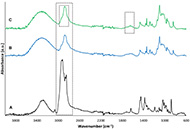 Isolation, characterization, and encapsulation of a lupeol-rich fraction obtained from the hexanic extract of Coccoloba uvifera L. leavesOpen AccessOriginal ArticleAim: This study aimed to isolate, characterize, and encapsulate a lupeol-rich fraction obtained from the hexanic extract of Coccoloba uvifera L. leaves to evaluate its potential use in nutraceuti [...] Read more.Carla N. Cruz-Salas ... Juan A. Ragazzo-SánchezPublished: August 28, 2023 Explor Foods Foodomics. 2023;1:115–129
Isolation, characterization, and encapsulation of a lupeol-rich fraction obtained from the hexanic extract of Coccoloba uvifera L. leavesOpen AccessOriginal ArticleAim: This study aimed to isolate, characterize, and encapsulate a lupeol-rich fraction obtained from the hexanic extract of Coccoloba uvifera L. leaves to evaluate its potential use in nutraceuti [...] Read more.Carla N. Cruz-Salas ... Juan A. Ragazzo-SánchezPublished: August 28, 2023 Explor Foods Foodomics. 2023;1:115–129
DOI: https://doi.org/10.37349/eff.2023.00010
This article belongs to the special issue Natural Products in Health and Disease -
